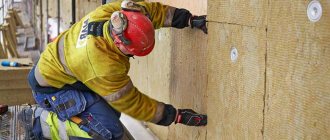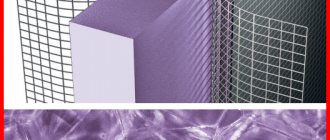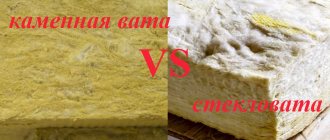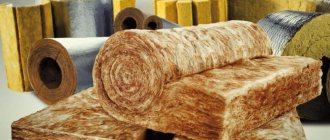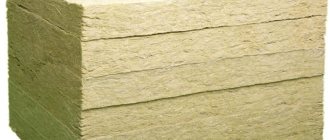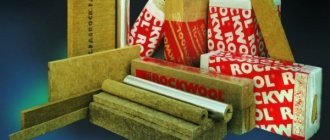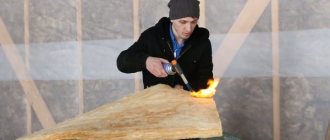Any living space must be properly insulated. Maintaining a comfortable temperature is one of the primary tasks that must be solved when constructing a new facility, or after a period of time during its operation. One of the reliable and high-quality materials that can be used to retain heat indoors is mineral wool.
What is mineral wool?
The definition of mineral wool is enshrined in GOST 31913-2011. According to him, mineral wool is a class of fibrous materials that are obtained from metal slag and molten rocks.
In fact, the concept of mineral wool refers to not one material, but four:
- glass fiber;
- slag;
- stone wool;
- basalt wool.
All four types have a similar mineral wool composition, but differ in the length and thickness of the fiber. Differences in structure determine the properties of the material. You need to understand what kind of mineral wool you need, because the scope of application depends on its basic parameters; different types of mineral wool have different thermal conductivity, moisture resistance, resistance to mechanical loads, and so on.
Mineral wool insulation was used back in Soviet times as a reliable, high-quality and safe insulation material.
Composition of mineral wool (What is mineral wool made of):
Next, we will dwell in more detail on the question: what is mineral wool made of, because mineral wool from different manufacturers can differ in both density and composition:
- The basis of mineral wool is made up of various rocks. Gabbro-basalt and carbonate rocks are a by-product of metal production. They are used as raw materials for the production of glass wool fibers. Rocks make up 90% of mineral wool. The remaining 10% are various additives.
- Various binders are used to tightly bind the fibers. For these purposes, phenol-based resins and bentonite clay are used.
- The material is covered with a thin layer of paper on top. Usually it is kraft paper with polyethylene or aluminum.
We have listed the main components of mineral wool (about 99% of all mineral wool products consist of them). To find out in more detail what type of mineral wool is in front of you: its composition is indicated on the packaging.
Myth No. 3. Damage from fire of mineral wool
The most ridiculous myth about mineral wool is the high probability of the material igniting upon contact with fire. The absurdity of this assumption is obvious, because the basis of mineral wool is fibers obtained from stone. And, as you know, it is impossible to burn a stone. You cannot burn its derivatives either.
Of course, if you direct the flame of a gas burner at a layer of insulation, it will not withstand the force of the fire. But it won’t catch fire, it will simply char and turn black. There is no further spread of fire, the mineral wool does not smolder and does not release harmful substances into the air. The material is fire-resistant and can be used in facilities with a high fire hazard.
Mineral wool is a material that, in the event of a fire, will not allow the fire to spread to other rooms and buildings
Mineral wool: varieties
Next, we will tell you what kind of mineral wool there is: in total there are four types of wool - glass wool, slag wool, stone and basalt wool. The last two types have excellent characteristics. The use of the first two types can only be justified by a modest project budget.
Glass wool
This is the most common mineral wool insulation. The fiber thickness of this type of wool is 5-15 micrometers, and the length is up to 5 centimeters. Such characteristics make cotton wool strong and elastic. Care must be taken when working with this material. If the fiber is damaged, glass threads can hurt a person. You should also be careful not to inhale damaged fibers, as fiber particles may enter the lungs. For this reason, when working with this type of mineral wool, builders use special clothing - a respirator, goggles, gloves and a special protective suit.
Technical parameters of glass wool:
| Thermal conductivity coefficient | 0,030 — 0,052 |
| Maximum temperature | 500 degrees Celsius |
| Minimum temperature | -60 degrees Celsius |
| Hygroscopicity of the material | low |
Slag
The fiber thickness of this type of wool is 4-12 micrometers and the length is 1.6 centimeters. This material (like glass wool) has a lot of fatal shortcomings that prevent its use as insulation. It has residual acidity. Because of this, such a material will easily interact with various metal surfaces, oxidizing them. This material easily absorbs moisture. Therefore, it cannot be used for cladding rooms, plastic and metal pipes. It is very prickly, which causes a lot of inconvenience during installation.
Technical parameters of slag:
| Thermal conductivity coefficient | 0,460 — 0,480 |
| Maximum temperature | 300 degrees Celsius |
| Minimum temperature | -50 degrees Celsius |
| Hygroscopicity of the material | high |
Stone wool
What is this type of mineral wool made of: gabbro and diabase, the fiber thickness of this type of wool is 5-12 micrometers, and the length is 1.6 centimeters. This material in its properties resembles slag wool. However, this material does not prick, which will be a big plus during installation. Stone wool does not absorb water well. Therefore, it can be used for heating cladding of premises.
Technical parameters of Stone wool:
| Thermal conductivity coefficient | 0,048 — 0,077 |
| Maximum temperature | 600 degrees Celsius |
| Minimum temperature | -45 degrees Celsius |
| Hygroscopicity of the material | low |
Basalt wool
This type of material is also made from gabbro and diabase. Does not contain blast furnace slag and various additional substances - dolomite, limestone and others. Basalt wool is usually wound into rolls. Mineral wool insulation does not deteriorate during winding. Due to its properties, the material can be used as insulation. This material is very difficult to set on fire. If you bring it to the fire, the fibers will only melt, but the material itself will not burn.
Technical parameters of Basalt wool:
| Thermal conductivity coefficient | 0,035 — 0,042 |
| Maximum temperature | 1000 degrees Celsius |
| Minimum temperature | -190 degrees Celsius |
| Hygroscopicity of the material | very low |
Raw materials for the production of insulation
Mineral wool is a fibrous insulation material, the properties and structure of which depend on the source raw materials. Three types of material are used for its production:
- glass;
- blast furnace slag;
- rocks - dolomite, basalt, diabase.
Raw materials for mineral wool production must produce stable fibers during processing and have a low melt temperature. The material is used in its pure form (basalt, diabase) or as part of a mixture. The diameter and length of the fibers depends on the chemical composition of the raw material. Their standard size is 1-10 microns, length from 2-3 mm to 20-30 cm. As the fiber diameter increases, its thermal conductivity increases, so the parameter value is usually limited to 8 microns. Long fibers add softness and elasticity to products.
Mineral wool: types
Mineral wool is usually sold in the form of solid slabs and mats. The use of mineral wool is for lining walls, ceilings and roofs. Mineral wool allows you to work with non-standard surfaces. Types of wool for insulation differ in density; in accordance with this difference, several brands are distinguished. There is light grade mineral wool, the density of which is up to 75 kilograms, but its scope is small.
Mineral wool grade P-75
Main characteristics:
- Material density - 75 kg per cubic meter. m.
- This soft mineral wool is used to insulate horizontal surfaces with light loads. An example of this type of surface is attics.
- This material is often wrapped around district heating, gas and oil pipes to retain heat.
Mineral wool grade P-125
Main characteristics:
- Material density - 125 kg per cubic meter. m.
- Used for insulation of ceilings, floors, interior walls and partitions.
- The material has good sound insulation.
Mineral wool brand PZh-175
Main characteristics:
- Material density - 175 kg per cubic meter. m.
- The material is very dense and has increased rigidity.
- Used for thermal insulation of reinforced concrete and metal walls and ceilings.
Mineral wool brand PPZh-200
Main characteristics:
- Material density - 200 kg per cubic meter. m.
- The material is very dense and has increased rigidity.
- Thanks to special additives it has high fire resistance.
- This construction mineral wool is usually used for thermal insulation of reinforced concrete and metal walls and ceilings.
Areas of application
Mineral wool is used for heat and sound insulation of buildings and structures, as well as structures and pipelines. Specific Applications:
- Thermal insulation of walls and ceilings of baths
- Unloaded insulation of enclosing structures of any spatial position of all types of buildings
- Thermal insulation of suspended ventilated facades
- Insulation in wet facade systems
- Isolation of industrial equipment, networks and highways
- Thermal and sound insulation of roofs
What are the main advantages of mineral wool?
This material is respected by ordinary people and experienced builders. And this is no coincidence:
- High fire resistance. In the production of some types of wool, only non-flammable silicate rock melts are used. This provides the material with a high degree of fire resistance. This type of wool does not burn under the influence of high temperatures, and also does not deform. For this reason, mineral wool is used to line rooms where various flammable substances are stored.
- Chemical resistance. Cotton wool does not react well with various chemicals, which makes it possible to use it for lining laboratories, various workshops, and school chemistry classes.
- Resistance to biological irritants. Neither fungi nor various harmful insects and rodents like mineral wool.
- Minor shrinkage. Many materials shrink over time, losing their original volume. This is especially critical for various joint structures, when reducing the size of one of the blocks can lead to a violation of the tightness of the room. Mineral wool does not have this drawback.
- Extremely low hygroscopicity of some varieties of mineral wool. Hard mineral wool absorbs up to 0.5% of liquid. For this reason, the material does not accumulate water.
- High vapor permeability. Cotton wool allows various water vapors to pass through well. This allows you to quickly remove unpleasant odors from the room. Condensation will not settle on such cotton wool.
- High sound insulation properties. This type of wool can be used to sheathe rooms not only for the purpose of insulation, but also to protect the room from extraneous noise.
- Environmental friendliness. The material is safe for humans and does not cause any allergic reactions.
- Easy to install. Mineral wool was made specifically to facilitate the insulation of rooms. Even an amateur builder can install this material.
- Durability. The service life is about 70 years, so you will not have to change the coating several years after installation.
Is mineral wool harmful to health or not?
Mineral wool is one of the materials that has both ardent opponents and supporters who claim that this is the best way to quickly and efficiently insulate a house. Most often, a negative opinion is generated by rumors or the example of friends who have chosen low-quality material. Well-known manufacturers take into account that today, when choosing insulation, the buyer’s attention is paid not only to the thermal insulation qualities and cost of the product, but also to environmental friendliness, non-flammability, vapor and moisture permeability.
There is a way to eliminate the destructive effects of formaldehyde and phenol - choose mineral wool and other materials for construction and repair, studying all the documents provided by the seller for products that you will have to live next to for many years. Compliance with the technology of production and installation of slabs or roll insulation allows you to protect yourself and your loved ones from possible harm to health if processes are disrupted.
Advice! You can minimize the harm from mineral wool, which can be caused by the material when laying it, cutting slabs and rolls, by using protective equipment - a respirator, glasses, gloves, long sleeves. This will prevent the occurrence of an allergic reaction upon direct contact with the insulation.
Cellulose-based ecowool - an alternative to mineral insulation
What are the main disadvantages of mineral wool?
However, not everything is so smooth. Mineral wool has the following disadvantages:
- If the fibers are damaged, glass wool fragments can hurt a person. Often the damaged fibers are very small. Inhalation of damaged fibers may cause damage to the lungs and airways. This drawback can be solved very simply - buy a protective suit, gloves, goggles and a respirator.
- Mineral wool often contains formaldehyde resin. Under prolonged exposure to high temperatures, it can oxidize to phenol, which is poisonous. Therefore, when installing in not very safe conditions, experienced builders recommend wearing protective clothing and a gas mask.
Also remember that types of mineral wool, such as stone and basalt, do not have these disadvantages.
Advantages and disadvantages of the material
Like any other material, mineral wool has its positive and negative sides. Among the obvious advantages of using this material are:
- excellent hydrophobic properties;
- ease of use, installation and dismantling;
- has fire safety;
- has a high density;
- vapor permeable;
- insignificant load on the main structural elements (walls, ceiling);
- compact and convenient;
- depending on the brand, it is slightly susceptible to damage by rodents and insects;
- has long-term performance characteristics;
- holds its shape and volume well.
The disadvantages of mineral wool include its high cost, compared to a number of other thermal insulation materials, as well as harm to human health if used incorrectly. Basically, a health threat arises at the time of installation of the material itself, since particles of glass, slag and basalt dust can settle on the lungs.
Once construction is completed, the risk of inhaling these substances is reduced to almost zero. But in the case of using stone wool, there is a possibility of formaldehyde resins evaporating in the room, especially if the air temperature is above 25-30C. To avoid this, it is necessary to use a vapor-proof polyvinyl chloride film, covering it over the entire surface of the insulation.
For complete safety, it is best to try to use basalt mineral wool. The main thing is to purchase quality products from reliable manufacturers, then all risks and health hazards will be minimized.
Mineral wool: scope
Mineral wool is used as a building material. It is also used to insulate walls, pipes and various structures. Sometimes mineral wool is used to create sound insulation, but only basal wool has good noise-reducing properties.
Construction materials: mineral wool
In construction, mineral wool is used mainly as insulation. With its help, they create a special wall covering that does not let cold air into the room, but retains warm air. Usually walls are sheathed from the inside, but sometimes some types of cotton wool are also used for sheathing walls on the outside. Cotton wool is also used to insulate gas-carrying pipes on the streets and in the entrances of houses.
Mineral wool insulation: slabs
There are different types of mineral wool for insulation, but you should give preference to mineral wool slabs. And that's why:
- The slabs are easy and convenient to cut.
- The slabs are easy to transport and do not require special care.
- The slabs can be laid on an uneven surface to hide the imperfections of load-bearing walls.
Insulation errors
Often the reason for negative reviews about mineral wool as insulation from builders is installation errors:
- Insufficient amount of insulation. The optimal thickness in most cases is considered to be 10 cm.
- If the insulation was done from the inside (insulation of the walls in the apartment), then there is no need to dwell on this. When choosing between interior and exterior work, you should give preference to the latter.
- You cannot skimp on fasteners, or use inappropriate fasteners where they are inappropriate. It is important to remember that initiative is not always justified and can backfire.
- If the house has a basement, then it is necessary to pay attention to it, otherwise the insulation will not have the desired effect.
- Accuracy in work is necessary. It is worth laying the layer as evenly and densely as possible.
- It is important to pay special attention to preparing the foundation. Do not ignore cleaning the surface from debris and sanding it in case of unevenness. In the worst case, the insulation will simply fall off the wall.
- It is necessary to avoid getting glue into the joints of the boards. In this case, this is where the cold will come in.
- Insulation work must be carried out in warm, dry weather. It is necessary to remember - no moisture.
- When attaching the mesh, one important rule should be taken into account - we use only glue, we keep the putty for other work.
- It is necessary to insulate at least 60% of the surface to achieve the desired result.
